So, what would we expect in a possible FM(x) in the future ? Over the last two decades, the most significant of SLR development were on the path of autofocus technologies supplemented by 'smart' metering and programmed exposure control. All these great features found on a modern SLR were primarily aimed to make camera simpler to use and surer in getting a technically more successful photography. To a great extend, it helps. But along the way, camera manufacturers assume everyone will enjoy such simplicity they defined such as the use of LCD's picturegraph and icons on dials and buttons.
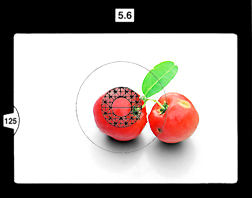 |
But little they realize it actually requires a photographer to have a fair level of fundamental and handling of digital equipment as well as photographic basic to operate such 'simple gadget' which most manufacturers thought it was nothing more simpler than what they can offer right now. |
<<--- Copyright ©-Free images collection, 2000
leofoo® Malaysian Internet
Resources. Contradictory, simplicity is actually
the strongest element one find in the FM2(n). Some even consider microprism and split
image rangefinder focusing reference confusing -- Oh, wait till you experience AF
sensors in a modern AF SLR, where half of the time when using the camera, one has
to worry whether the camera will go out of focus without pointing the sensor onto
subject correctly ...
As far as I am concerned, there is only two ways to spec the possible FM(x) in the future. One way is a conservative
approach where it will upgrade the FM2(n) to match or slightly better off than its
competitions. Which means a 1/8800 sec, a spot/partial metering and likely a basic
TTL flash exposure control may be added to its 20 years old spec of 1/4000 sec maximum
shutter speed, center weighted metering system and normal auto/manual flash. That
is a more likely route Nikon would adopt, given their corporate culture and more
importantly, it has little to stress their financial to allocate more fund in R&D
for such a possible model, because, all these features mentioned are technologies
of at least 18 years old ! Besides, Nikon can still claim: "..We are listening
all these years and we do care...." and it should make some blindfolded followers
and reviewers keep yelling "..Viva
Nikon
! ". Naturally, we have to cough out a hundred or two more for such possible
upgrade. That is, if Nikon just aims to stay competitive with rivaling brands such
as Contax S2/S2b, Olympus OM-2000, Leica's R6.2 etc. and position themselves safely
for the next few years. What if they are little aggressive and aim to put the new
model ahead of competitions for the nest 10 -15 years ? Hmmm... that is a different ball game.
Nikon has always been strong at metering (ambient/ flash exposure control). But I
don't think Matrix is 'suitable for a fully manual/mechanical camera body such as
the FM2n or FM(x). Why would you want
to invest in a mechanical SLR such as the FM2n these days? Is it that you wanted
a mechanical camera as backup body for an important assignments to your all electronic
Nikon F5, F100 etc.. ? Or you know little about photography and wants to start from
scratch and bare basic; or just a advice from a lecturer from your college etc..
. The reasons could be plenty, but boils down to a fact, that is: It is a camera
that allows the user to command the hardware rather than depending on technologies
that dictate (logically, if you are so fragile in your confidence and wants to be
slavery to technology, buying a F70 or F80 would be more logical then, right ? ).
The partial or spot metering would be helpful to assist the time proven reference metering guide provided by counterweighted average metering if one uses exposure-latitude-tight slide films very often. TTL flash exposure control should improve functionality of the FM(x) in areas such as macro and multiple flash setups photography with the extensive collection of TTL flash models Nikon has produced so far since their first TTL flash SB-12 designed for their Nikon F3 way back in 1980.
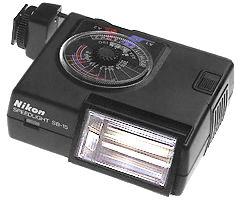 |
The current sync speed of 1/250sec first made possible with FE2 back in 1982 has remained a market reference ever since until the Minolta marginally improved it to 1/300sec with their Minolta 9xi and followed by the Nikon F5 in 1997. |
To make it more convincing, todate - Canon has only four of their camera models, T90 (1986), EOS-1(1989), EOS-1n (1994) and the steaming hot EOS-1v (2000) that provide similar maximum sync speed of 1/250sec as with the Nikon FM2n of 1983 !. Obviously, there seems to be technical problems for everyone of them to provide users with an appropriate value added product for the last 18 years... The multi-spots metering's theory first debuted on a Olympus OM3/4 in 1984 would sound perfect but I can guaranteed you unless you have all the time in the world to wait for a shot to happen or situations in your favor, after the initial thrills of toying around with it, you will hardly use them later as it is too tedious to setup. After all, we are buying a camera to express what we feel captured on film, quickly - and not spending half of our time figuring out what exposure should be set. Thus, a sole partial/spot with a plain convenience by just activated a lever would be more welcome. Overall, the biggest threat of FM2(n) actually comes from Contax S2 series models at serious amateurs market and Olympus OM2000 at entry level market; both presents some very good spec, features and some very logical reasons to be a a stiff competitor to the current FM2(n) models. How about Olympus pioneered Highlight/Shadow control ? Although the idea sounds good (It was borrowed by the mighty Canon T90 of 1986 as well, where Canon 'modified' its concept to provide H/L exposure control of +- 4 stops ! ), but essentially it is just a variation of automated exposure control for high key and dark contrast shots similar with adjusting exposure manually via ASA film speed setting, stop or opening up the lens diaphragm or adjusting shutter speed scales, all of which would achieve similar effects but leaves little benefit to someone who wants to pick up more experience into handling such photographic situations. For a mechanical camera, I don't encourage such inclusion.
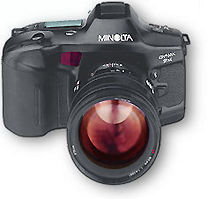 |
The shutter mechanism. With the breakthrough of achieving 1/8800 sec maximum shutter speed by the Nikon F801 in 1988, Nikon should had enough experience to provide a safe and reliable cushion in a high speed mechanism for the possible new mechanical camera. You may ask why higher top speed of 1/12000 sec or 1/16000 sec in not in my agenda ? |
Well, because, generally that is not a top priority for a photographer as 1/8800 sec should be enough to handle virtually all imaginable general photographic situations; moreover, the extra one stop in speed gain to 1/16000sec would stress the shutter mechanism more to affect reliability. Frankly, although another reasons for such high speed may be used to gain depth of field control when using high speed film in brightly lit situations, but I would like to think such should be film manufacturers' responsibility (Why won't there be a smart fine grain film that allow shooting at ASA 50 and ASA 3200 exist ? ... and they also show little interest and do little improvement in this area for the last 20 years other than price spiked with marginal improvement over film emulsion technology !). Well, actually I have been thinking for quite a while how serious can Nikon be in provides us with an worthy upgrade in the new FM(x) in the future. Why am I picking on them ? No. I am not. Sometimes, it just need a little imagination and possibly could resolve many issues. I am not so sure how many of you actually handle a pellicle mirror camera before, but certainly it worths a look as a solution.
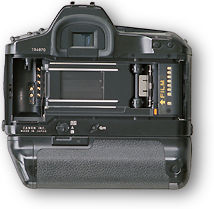 |
Technically, it is possible to commercialize pellicle in high volume as with Canon did it with their highly affordable conceptual SLR that equipped with a fixed mirror (Canon RT of 1989 ) which followed by highly successful professional class model, EOS-1n RS in 1995. |
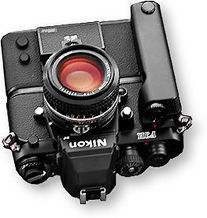 |
Nikon is no stranger to Pellicle Mirror technology. In fact, they can safely claimed as a pioneer in that segment because back in 1971, a variation of the original Nikon F, Nikon Original High Speed Motor Drive Camera equipped with a fixed Pellicle Mirror has achieved a speedy film advance rate of 7 fps (Frames per second). That was followed by another speed monster upgrade specially designed for Montreal Olympic which delivered a even faster rate of 9 fps ! That is not all - another model, Nikon F2 High Speed Motor Drive camera with a Titanium body casing with a special MD-100 motor drive was developed with marginally higher speed of 10 fps back in 1978. In fact, the fastest rapid winding camera models among all Nikons is a 13.5 fps high speed demon Nikon F3 High Speed Motor Drive with a special MD-4E motor drive introduced a few years ago in 1996. All these bodies were using a fixed, non-reflex Pellicle Mirror. What benefits can it bring ? |
Well, with a fixed mirror, there will be absolute no mirror bounce and designer do not have to factor in timing or synchronization with shutter movement for designing a more reliable working shutter unit; further, it eliminate any possible movement caused by mirror bounce which effectively works like a mirror lock up. Multiple TTL or auto flash setup should works like a dream because you can actually seeing light striking onto subject in real time. But TTL metering with such camera can be technically very difficult to resolve and may demand a great R&D effort which I don't think Nikon will do it for a mechanical camera model such as FM class. Doubting what I have said ? Just a clue, none of the High Speed Motor Drive camera models mentioned incorporate a TTL open aperture metering, the latest F3H has to use stopped down metering even if it has the same metering cells residing at the same location as the normal F3. Technically, TTL flash is possible for that model. Naturally, with all the accumulated experience dealing with Pellicle Mirror technology over the last few decades, if ever the new model carries with such possible design, I would expect it to provide a reliable ultra-fast high speed film advance rate of 8-10 fps. Of cause, one would expect the new motor drive would work like the older Nikon FA/MD-15 or Nikon F3/MD-4 combination which will power the camera's metering circuit as well. Of cause, they should revive production of the obsolete slower MD-15 which will cost them nothing in R&D to enable a slower and cheaper motor drive as alternative. This should spearhead and strengthen its leads over competitions in this segment where others still have difficulty getting a capable motor drive for their respective mechanical camera model.
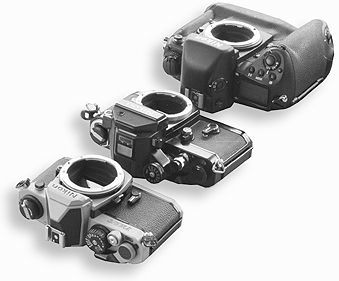 |
I don't think Nikon should integrate idea of a built-in winder into a new camera such as the FM(x). One of the key attraction of the FM2n is its compactness and light weight which has the advantage of high mobility. |
To pack something like a built in drive will, inevitably added up to the cost of production and bulkiness and leave little to the user to configure how and tailor setup his camera to best suit each photographic assignment. Further, why should they force anyone to accept a spec sheet that they have pre-determined what features it should have and how we should use the camera they designed without any consideration to let us decide what we want ? In fact, among all these possibilities, there is a great potential to have a multi-command film back to integrate remote control, time lapsed capabilities that integrate directly with the new motor drive (The camera body will not perform such function on its own as it is essentially a mechanical SLR, it has to go through a medium such as a winder or motor drive); but again, unfortunately, it may boil down to another fact, i.e. production cost and make the new camera with a unrealistic market price again.
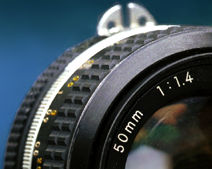 |
Anyway, theoretically all these possibilities can be realized given price factor is not an issue and users are still ever enthusiatical about mechanical camera bodies. Despite what I have said, I'd think we should retain the FM2n as we seriously lack a well made SLR with bare minimum spec for starters who will form the core driving force for photography in time to come. |
Little will those young executives at Nikon headquarters realize these new crops of SLR users may emerge as the force to keep their company financial healthily maintained - only in the long run rather than resorting to drastic action to "milk" their faithful consumers so quickly as with they did lately with the F80's controversal decision to 'disable' certain basic metering and exposure control function if a manual focus (non-AF) Nikkor lens is used... There must have solutions, ways and means such as reallocating production facilities to a third world country or outsourcing them to a more competitive manufacturer such as Cosina which should have established good manufacturing basics after their effort with the Nikon FM10 project. But hopefully, this time around, Nikon would pay more attention to quality issues to product bearing their trade name.
| Previous | Next |(5/5 parts)
Standard
production Nikon FM Series models:-
Nikon FM | Nikon FM2 | Nikon FM2n | Nikon FM10 | Nikon FM3a |
Known
variants:-
Nikon
FM Gold
| Nikon
FM2/T
| Nikon
FM2N Tropical Set
| Nikon
FM2/T Limited Edition
| Nikon
FM2N LAPITA
|
Nion
FM2n Millennium 2000
| Back | Index
Page of Nikon FM2 models
| Back | Index
Page of Nikon FM2(n) models
| Back | Main Index
Page of Nikon FM series Bodies
| Back | to Pictorial History of Nikon Rangefinder/SLR/Digital cameras
| Message Board | for
your favourite Nikon
FM Series SLR models
| Message
Board | for your Nikon
Optics in a shared environment
| Message Board | Specifically for Dispose or Looking for Nikon/Nikkor
Photographic Equipment
Shared Resources: MD-11 | MD-12 | Focusing Screens | Titanium Shutter | Flash Units -SB-16 | SB-15 | SB-10 or other Options | Databack | Nikkor lens mount (related info)
Others:- Nikon AF-TTL Speedlights | SB-20 (1986) | SB-22 (1987) | SB-23 | SB-24 (1988) | SB-25 (1991/2) | SB-26 (1994) | SB-27(1997) | SB-28 (1997) | Nikon SB-29(s) (2000) | Nikon SB-30 (2003) | Nikon SB-600 (2004) | Nikon SB-800 (2003) Nikon AF-TTL Speedlight DX-Series: Nikon SB-28DX (1999) | SB-50DX (2001) | SB-80DX (2002)
Nikon
BC-flash Series |
Original
Nikon Speedlight
SB-2
| SB-3 | SB-4
| SB-5
| SB-6 | SB-7E
| SB-8E
| SB-9 | SB-E
| SB-10
SB-11
| SB-12 | SB-14 | SB-140 UV-IR| SB-15 | SB16A | SB-17 | SB-18, SB-19 | SB-21A (SB-29) Macro flash | Flash Accesories | SF-1
Pilot Lamp
Instruction
Manual: Nikon FM (HTML | PDF) | Nikon FM-10 (HTML) | Nikon FM2n's
User's Manual
available only in HTML format (6
parts) | Nikon
FM3A
(HTML)
Specifications: Nikon FM, FM-10, FM2, FM2n and FM3A / Main
Reference Map: (HTML) Nikon FM, FM2, FM-10, FM2n (Applicable
to FM2T, FM2 "Year of the Dog"; Millennium 2000") and Nikon FM3A
| Nikon F | Nikon F2 | Nikon F3 | Nikon F4 | Nikon F5 | Nikon F6 | Nikkormat / Nikomat | Nikon FM | Nikon FE/ FA | Nikon EM/FG/FG20 | Nikon Digital SLRs | Nikon - Other models |
Nikon Auto Focus Nikkor lenses:- Main
Index Page
Nikon Manual Focus Nikkor lenses:- Fisheye-Nikkor Lenses - Circular | Full Frame |
Ultrawides Lenses - 13mm15mm18mm20mm | Wideangle Lenses - 24mm28mm35mm | Standard Lenses - 45mm 50mm 58mm | Telephoto
Lenses - 85mm105mm135mm180mm & 200mm | Super-Telephoto Lenses - 300mm 400mm 500mm 600mm 800mm 1200mm |
 Index Page |
Special
Application lenses: Micro-Nikkor Lenses - 50mm~55mm -60mm 85mm -105mm 200mm Micro-Zoom 70-180mm Perspective Control (PC) - 28mm 35mm PC-Micro 85mm Dedicated Lenses for Nikon F3AF: AF 80mm f/2.8 | AF 200mm f/3.5 EDIF Depth of Field Control (DC): 105mm 135mm Medical Nikkor: 120mm 200mm Reflex-Nikkor Lenses - 500mm 1000mm 2000mm Others: Noct Nikkor | OP-Nikkor | UV Nikkor 55mm 105mm | Focusing Units | Bellows-Nikkor 105mm 135mm Nikon Series E Lenses: 28mm35mm50mm100mm135mm | E-Series Zoom lenses: 36~72mm75~150mm70~210mm |
MF Zoom-Nikkor Lenses: 25~50mm | 28~45mm | 28~50mm | 28~85mm | 35~70mm | 36~72mm E | 35~85mm | 35~105mm | 35~135mm | 35~200mm | 43~86mm | 50~135mm | 50~300mm | 70~210mm E | 75~150mm E | 80~200mm | 85~250mm | 100~300mm | 180~600mm | 200~400mm | 200~600mm | 360~1200mm | 1200~1700mm
Tele-Converters: TC-1 | TC-2 | TC-200 | TC-201 | TC-300 | TC-301 | TC-14 | TC-14A | TC-14B | TC-14C | TC-14E | TC-16 | TC-16A | TC-20E
Recommended links to understand more technical details
related to the Nikkor F-mount and production Serial Number:
http://rick_oleson.tripod.com/index-153.html by: my
friend, Rick Oleson
http://www.zi.ku.dk/personal/lhhansen/photo/fmount.htm by: Hansen,
Lars Holst
http://www.mir.com.my/rb/photography/hardwares/nikonfmount/lens2.htm
http://www.photosynthesis.co.nz/nikon/serialno.html
W A R N I N G: The New G-SERIES Nikkor lenses have no aperture ring on the lens, they CANNOT ADJUST APERTURES with any of these manual focus Nikon FE series SLR camera models; please ignore some portion of the content contained herein this site where it relates.
|
Back | Main Index Page of Nikkor Resources
|
Back | Main Index Page of Pictorial
History of Nikon SLRs
| Message Board | for your Nikkor optics ("shared" because I do wish some of you to expose to other's perspective as well. Isn't it a sad sate to see photography has to be segmented into different camps from the use of various labels)
about this photographic web site
Home - Photography in Malaysia |
Credit: To all the good people who has contributed their own experience, resources or those who are kind enough granting us permission to use their images appeared in this site. Mr. MCLau®, who has helped to rewrite some of the content appeared this site. Chuck Hester® who has been helping me all along with the development of all these Nikon websites;LarsHolst Hansen, 'Hawkeye' who shares the same passion I have; Ms Rissa, Sales manager from Nikon Corporation Malaysia for granting permission to use some of the official content; TedWengelaar,Holland who has helped to provide many useful input relating to older Nikkor lenses; Some of the references on production serial numbers used in this site were extracted from Roland Vink's website; HiuraShinsaku from Nikomat Club Japan. t is also a site to remember a long lost friend on the Net. Note:certain content and images appeared in this site were either scanned from official marketing leaflets, brochures, sales manuals or publications published by Nikon over the years and/or contribution from surfers who claimed originality of their work for educational purposes. The creator of the site will not be responsible for may discrepancies arise from such dispute except rectifying them after verification."Nikon", "Nikkormat", "Nippon Kokagu KK" & "Nikkor" are registered tradename of Nikon Corporation Inc., Japan. Site made with an Apple IMac.